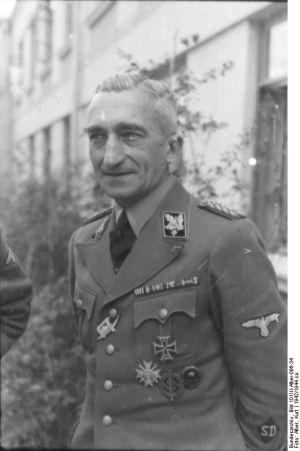Arthur Nebe

Arthur Nebe
Arthur Nebe was born on 13 November 1894, the son of an elementary school teacher. After volunteering for military service during the First World War, Nebe joined the criminal police (Kripo) and reached the rank of Police Commissioner in 1924. Nebe was a professional policeman and the author of a respected work on criminology. Arthur Nebe entered the NSDAP and the SS during July 1931 and a few months later he also joined the SA. Even before the Nazis came to power Nebe was their liaison man in the Berlin criminal police, with close links to the SS group led by Kurt Daluege, who in April 1933 recommended him as Chief Executive of the State Police. The former Chief of the Berlin CID under Weimar, Nebe was given the task of re-organising the criminal police in the Third Reich. As head of the Kripo and a high Gestapo official, Nebe played an important part in the establishment of the totalitarian police system.
In September 1939 he was put in charge of Amt V of the Reich Main Security Office (RSHA), which was responsible for the criminal police. Nebe was promoted to the rank of SS- Gruppenführer and he was later given command of Einstatzgruppe B between June and November 1941. This was one of the four extermination commandos formed for the invasion of the Soviet Union during the early summer of 1941. Einsatzgruppe B’s headquarters were in Minsk, White Russia, and they were assigned to the Army Group Center and their main sphere of activity covered Minsk and Smolensk. During the period of five months, Arthur Nebe was credited with the ‘modest’ number of 46,000 executions, and Heinrich Himmler visited Minsk during August 1941. Himmler instructed Nebe to carry out in his presence an execution of one hundred inmates of a prison in Minsk. According to Karl Wolff, who was then Himmler’s Liaison Officer at Hitler’s headquarters, recalled that Himmler was badly shaken by the gruesome experience and instructed Nebe to find a better method for the mass murder. Arthur Nebe and Dr Widmann, of the Criminal Police carried out a number of experimental killings of patients from various lunatic asylums in Minsk and Mogilev, using explosives and poison gas. In Mogilev, at a local lunatic asylum, a room was closed hermetically and approximately thirty inmates were gassed using carbon monoxide from the engine of a car parked outside, via pipes connected from the car to the gas chamber. After the Second World War ended an amateur film of this gassing was found in Nebe’s apartment in Berlin.
Nebe’s alleged disquiet at the mass murder is somewhat weakened by a letter he wrote on 28 June 1944, recommending the use of so-called ‘half-breed’ gypsies from Auschwitz for human guinea-pig experiments such as drinking sea water. Nebe was involved in the July 1944 plot against Hitler. Though not under suspicion he chose to go into hiding on an island in the Wannsee and was betrayed by a rejected mistress. According to official records, Arthur Nebe was executed in Berlin on 2 March 1945, in the Plotzensee prison.
Sources
Robert S. Wistrich, Who’s Who in Nazi Germany, Routledge, London and New York 1995
Gerald Reitlinger, The Final Solution, Vallentine, Mitchell & Co 1953
French L. Maclean, The Field Men, Schiffer Military History, Atglen, PA 1999
Yitzhak Arad, Belzec, Sobibor, Treblinka, Indiana University Press, Bloomington and Indianapolis1987
Photograph – Bundesarchiv
© Holocaust Historical Society 2015


